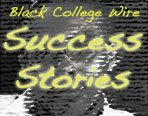| Howard Alumnus Is Writer of 'New in Town' |  |
 |
 |
| By Aleesa Mann -- Black College Wire | |
|
Ken Rance wasn’t always the Hollywood type. But now, 16 years after graduating from the Howard University School of Communications, Rance has made it to the silver screen as writer of his first major motion picture, “New In Town.” The film, which opened in theaters recently, tells the story of an ambitious businesswoman who moves from the big city to a rural town where she unexpectedly finds love and acceptance. “New In Town” was inspired by Rance’s chance encounter with Letisha Strawbridge, an African-American Kraft Foods executive. 
Personal photo
Ken Rance
“I was just so intrigued by some of the struggles and challenge of her being down there,” Rance said. “I wanted to address the film about loneliness and exploring the question ‘Can a woman have both the corporate brass ring and a family life?’” Can she have both? It’s a question Rance tackles in the film, which stars big names including Renee Zellweger as Lucy Hill, the ambitious executive, and Harry Connick Jr. as Ted Mitchell, her homely love interest. Although the story plays out smoothly onscreen, there is one question left hanging in the minds of those who know the film’s inspiration: Where is the African-American lead actress? “I showed [the screenplay] to my agent in about 2000,” said Rance. “He said he really liked the screenplay but he didn’t feel he could sell it because it had an African-American female lead.” While pursuing his film in Hollywood, Rance was exposed to the racial undertones that still exist in the film industry. “New In Town” was originally written to star actress Gabrielle Union, but once the script was pick up by Gold Circle Film Pictures, the lead and her ethnicity was quickly changed for what was pegged as “salability.” In the economic interests of the studio, more moviegoers would pay to see a film starring a white woman than a black one. For Rance, the change was bittersweet. “I think it’s a testament to the quality of writing in that this story was universal,” said Rance. “[Race] wasn’t a real integral factor in the success of telling the story.” “But I do have to admit as a black man, as a black husband, and as a black father I always envisioned having that face on the DVD cover one in which my daughter could identify with,” he said. For some students, issues of race in the entertainment industry are no surprise. Despite the accomplishments of actresses like Halle Berry, who won an Oscar for her lead role in ‘Monster’s Ball’ (2001), there continues to be a disparity between film’s with black leads and audience turnout. The Box Office Mojo reports ‘Monster’s Ball’ as one of the highest grossing films since 1982 that never made it into the top 10 films as far as weekend sales. “I think it’s typical of what goes on in Hollywood,” said Liane Henry, sophomore acting major. “There are only a few black actors and they can only see them in particular roles.” “I see that as black actors it is our duty to try and kill that stereotype,” she said. Michael Calybourne, sophomore acting major agrees and believes black actors can work to expand their audience. “What we can do as black artists is continue to push the envelope on what we do and be very selective of how we go about pursuing our careers,” he said. Despite changes to the script, Rance always felt his film would become successful, but he says it wasn’t until he came to college that he was ready to take on the entertainment industry. “[Howard] gave me the courage, the training, some people would even say the naiveté or the stupidity to actually think that I could go out to Hollywood and make something for myself,” said Rance. “One of the things Howard instilled in me was a greater sense of self and self confidence in knowing more about who I was as a man, and as an African-American.” Rance formed a special bond with, Henry Joseph, former production manager for the Radio, TV and Film department, whom he called “Coach.” Joseph remembers Rance as a student with a Kid n’ Play hightop fade, braces, and a lot of potential. “Ken really took advantage of all the opportunities at Howard,” said Joseph. “He was always doing stuff, he wasn’t a procrastinator.” From photography and camera work, to editing and production, Joseph recalls Rance always had his hand in a film project. “Even with the braces and the hightop fade you had to take him seriously,” he added. And aside from the hightop fade and braces, not much has changed for Rance who says he still has “a lot of different projects on the burner.” According to Rance, the next wave of black movers and shakers in the entertainment industry are coming out of Howard University. He is among them. Aleesa Mann writes for The Hilltop, the Howard University student dewspaper, which originally published a version of this article. |
|
| Posted Feb. 16, 2009 |
| < Prev | Next > |
|---|



